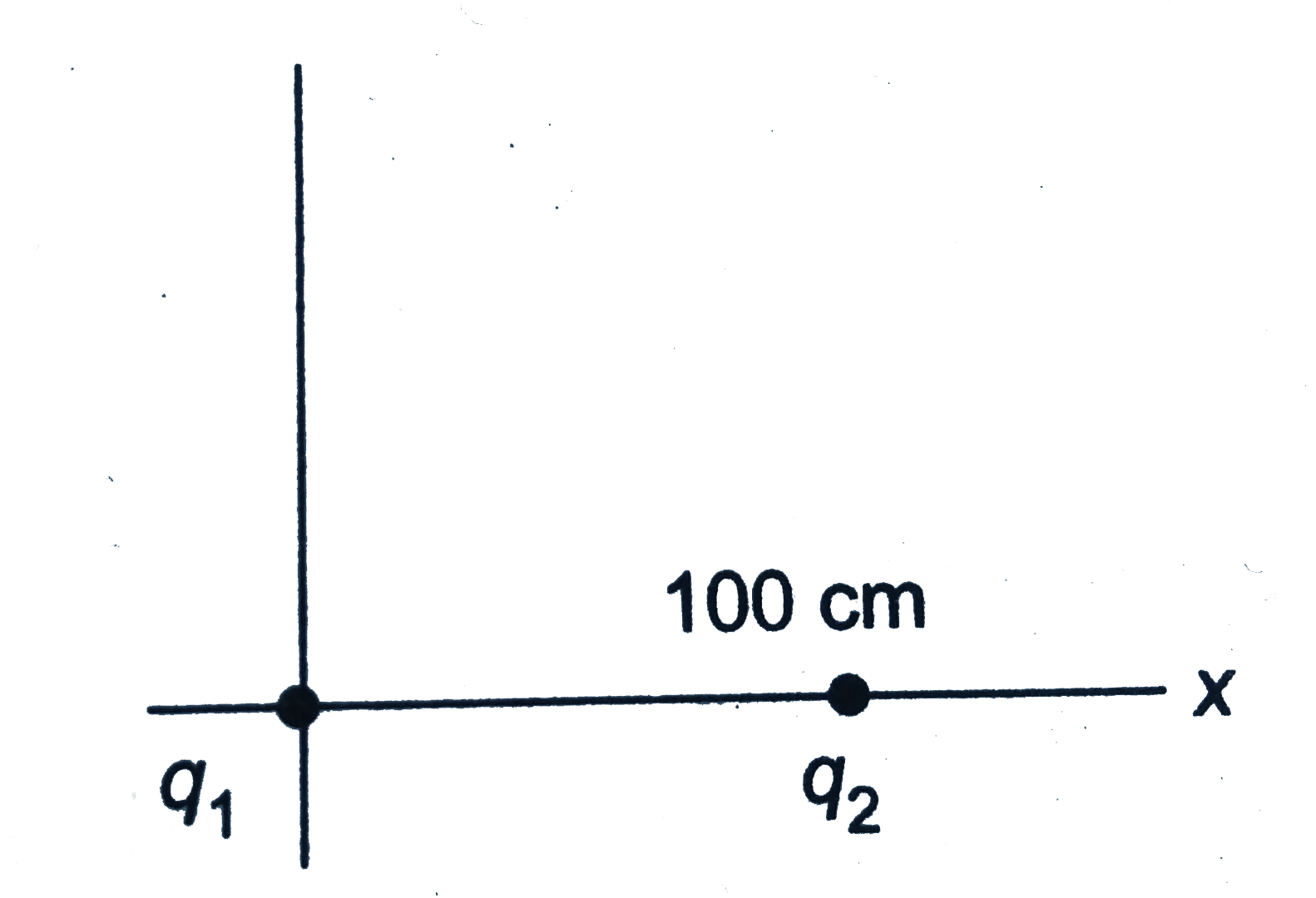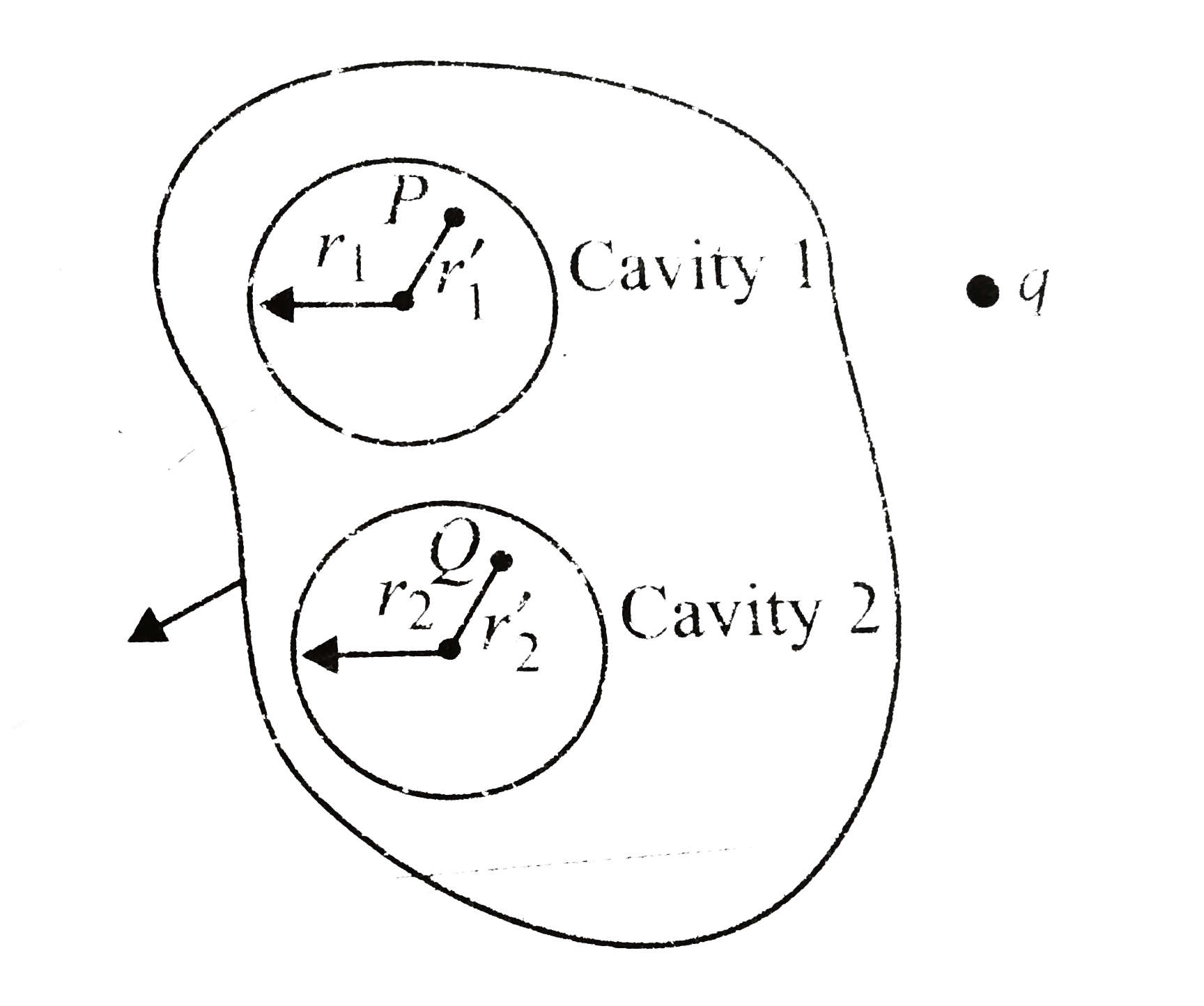A Point charge q1=4q0 is placed at origin.Another point charge q2=−q0 is placed at x=12cm. Charge of proton is qo0.The proton is placed on x axis so that the electrostatic force on the proton is zero.In this situation,the position of the proton from the origin is ________cm
To solve the problem, we need to find the position of a proton placed on the x-axis such that the net electrostatic force acting on it due to two other point charges is zero.
1. Identify the Charges and Their Positions:
- Charge q1=4q0 is located at the origin (0 cm).
- Charge q2=−q0 is located at x=12 cm.
- The charge of the proton is q0.
2. Let the Position of the Proton be x cm:
- We need to find x such that the net force on the proton is zero.
3. Write the Expression for the Forces:
- The force on the proton due to charge q1 (at the origin) is given by Coulomb's law:
F1=k|q1⋅q0|x2=k4q20x2
- The force on the proton due to charge q2 (at x=12 cm) is:
F2=k|q2⋅q0|(x−12)2=kq20(x−12)2
4. Set the Forces Equal to Each Other:
- For the net force on the proton to be zero, the magnitudes of the forces must be equal:
F1=F2
k4q20x2=kq20(x−12)2
5. Cancel Common Terms:
- We can cancel k and q20 from both sides:
4x2=1(x−12)2
6. Cross Multiply:
- Cross multiplying gives:
4(x−12)2=x2
7. Expand and Rearrange:
- Expand the left side:
4(x2−24x+144)=x2
4x2−96x+576=x2
- Rearranging gives:
3x2−96x+576=0
8. Divide the Equation by 3:
- Simplifying the equation:
x2−32x+192=0
9. Use the Quadratic Formula:
- The quadratic formula is x=−b±√b2−4ac2a:
- Here, a=1,b=−32,c=192:
x=32±√(−32)2−4⋅1⋅1922⋅1
x=32±√1024−7682
x=32±√2562
x=32±162
10. Calculate the Two Possible Values for x:
- x=482=24 cm
- x=162=8 cm
11. Determine the Valid Position:
- The proton must be between the two charges to experience a net force of zero. Since q1 is at 0 cm and q2 is at 12 cm, the valid position for the proton is:
x=8 cm
Final Answer:
The position of the proton from the origin is 8 cm.
- Charge q1=4q0 is located at the origin (0 cm).
- Charge q2=−q0 is located at x=12 cm.
- The charge of the proton is q0.
- We need to find x such that the net force on the proton is zero.
- The force on the proton due to charge q1 (at the origin) is given by Coulomb's law:
F1=k|q1⋅q0|x2=k4q20x2
- The force on the proton due to charge q2 (at x=12 cm) is:
F2=k|q2⋅q0|(x−12)2=kq20(x−12)2
- For the net force on the proton to be zero, the magnitudes of the forces must be equal:
F1=F2
k4q20x2=kq20(x−12)2
- We can cancel k and q20 from both sides:
4x2=1(x−12)2
- Cross multiplying gives:
4(x−12)2=x2
- Expand the left side:
4(x2−24x+144)=x2
4x2−96x+576=x2
- Rearranging gives:
3x2−96x+576=0
- Simplifying the equation:
x2−32x+192=0
- The quadratic formula is x=−b±√b2−4ac2a:
- Here, a=1,b=−32,c=192:
x=32±√(−32)2−4⋅1⋅1922⋅1
x=32±√1024−7682
x=32±√2562
x=32±162
- x=482=24 cm
- x=162=8 cm
- The proton must be between the two charges to experience a net force of zero. Since q1 is at 0 cm and q2 is at 12 cm, the valid position for the proton is:
x=8 cm
The position of the proton from the origin is 8 cm.
Topper's Solved these Questions
Similar Questions
A positive point charge q1 is placed at (a,0) and another positive point charge q2 is placed at (0,a) . Find the force acting on q1.
View SolutionA point charge q1=+2μC is placed at the origin of coordinates. A second charge, q2=−3μC, is placed on the x-axis at x=100cm. At what point (or points) on the x-axis will the absolute potential be zero?

View Solution
Knowledge Check
Two point charges are fixed on the Xaxis , q1=12.0mC is located at the origin and q2=−3.0mC is located at point A, with x2=8.0cm. Where should a third charge q3, be placed on the X-axis so that the total, electrostatic force acting on it is zero?
Aat x3=16cmBat x3=12cmCat x3=24cmDat x3=6cmA charge +q is located at the origin, while an identical charge is located on the x axis at x = +0.50 m. A third charge of +2 q is located on the x axis at such a place that the net electrostatic force on the charge at the origin doubles, its direction remaining unchanged. Where should the third charge be located ?
A+0.50mB+0.71mC−0.50mD−0.71mA point charge q1 is placed inside cavity 1 and another point charge q2 is inside cavity 2. A point charge q is placed outside the conductor. For the situation described above, answer the following questions.

The charge on outer surface of the conductor would beAQ+q1+q2 and nonuniformly distributedBQ+q1+q2 and its uniform or nonuniform distribution depends upon locations of q1andq2CQ+q1+q2 and would be distributed uniformlyDQ+q1+q2 and the distribution depends upon the locations of q1,q2,andq.
A point charge q1=4.00nC is placed at the origin, and a second point charge q2=−3.00nC, placed on the x-axis at x = + 20.0 cm. A third point charge q3=2.00nC is placed on the X-axis between q1,andq2. (Take as zero the potential energy of the three charges when they are infinitely far apart).
(a) What is the potential energy of the system of the three charges if q3 is placed at x= + 10.0 cm?
(b) Where should q3 be placed to make the potential energy of the system equal to zero?
View SolutionA point charge q is placed at the origin . How does the electric field due to the charge very with distance r from the origin ?
View SolutionFour point charges Q , q Q and q are placed at the corners of a square of side 'a' as shown in the Fig. Find the
resultant electric force on a charge Q
View SolutionA charge of +2μC is placed at x=0 and a charge of −32μc at x=60 .A third charge −Q be placed on the x axis such that it experiences no force .The distance of the point from +2μC is ( in cm)
View SolutionA point charge q1=−1.0μC is held stationary at the origin. A second point charge q2=+2.0μC moves from the point (1.0m,0,0) to (2.0m,0,0). How much work is done by the electric force on q2?
View Solution
